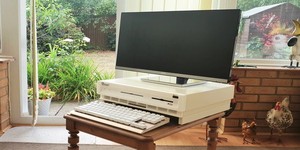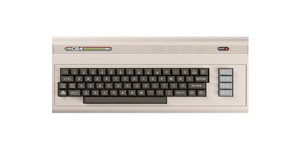Commodore USA announces the Amiga Mini
March 22, 2012 | 12:06
Companies: #a-eon #commodore #commodore-usa

Commodore USA has announced that it's bringing back the Amiga brand, in the form of the small form factor Amiga Mini. Before you get too excited, however: it's an Amiga in name only.
Designed by a team at Amiga Corporation led by Jay Miner in 1982, the Amiga was originally to be a games console. The game market crash of 1983 put paid to that, with Miner revising his design to take the form of a fully-functional microcomputer.
Demonstrated to the public at the Consumer Electronics Show in 1984, the Amiga was based around the popular 32-bit Motorola 68000 processor family. Running low on funds but eager to bring the device to market, Amiga Corporation agreed to be acquired by Commodore so the Amiga could be used as a next-generation replacement for the company's own ageing Commodore 64 and 128 8-bit microcomputers.
Despite a successful run from 1985 onwards, Commodore hit financial trouble in 1994 as companies turned towards IBM-compatible PCs and away from the microcomputers that had served the market so well in previous decades. Commodore sold the brand to Escom that year, which re-released selected Amiga models and created a new model known as the A4000T. Escom itself would go bankrupt in 1997, with US PC maker Gateway 2000 picking up the rights to the brand but failing to make use of it until its sale in 2000.
Now, the naming rights belong to Amiga, Inc., a holding company which licences the brand to third-parties for exploitation. These third party companies include A-EON Technology, creator of the AmigaOne family of PowerPC-based Amiga compatibles.
Amiga, Inc. also licences the brand to Commodore USA, a PC maker which has decided to revive both brands for the modern x86 PC era. Commodore USA's first major product under the brand was the Commodore 64, a modern PC crammed into a case designed to mimic the original 8-bit Commodore 64. While a clever design, it wasn't a great commercial success, despite including a Linux-based operating system pre-loaded with a Commodore 64 emulator for compatibility with classic software.
Commodore USA's latest creation, the Amiga Mini, is a serious departure from the design of the Commodore 64. Rather than using a traditional Amiga casing, in which the guts of the computer are packed beneath the keyboard, the company has opted to create a small form factor PC which has more in common with the Apple Mac Mini than anything the original Commodore ever produced.
Inside the svelte casing is an Intel Core i7-2700K 3.5GHz quad-core processor, running on an Intel Z68 Express mini-ITX motherboard. 16GB of DDR3 RAM is included as standard, along with an Nvidia GeForce GT 430 1GB GPU. Connectivity includes 802.11n Wi-Fi and a gigabit Ethernet port, while storage is a 1TB hard drive or optional 300GB or 600GB solid-state drive. Finally, a slot-loading Blu-ray optical drive is located at the front.
As with the Commodore 64, Commodore USA's Vision OS is pre-loaded and provides an emulator for using traditional Amiga or Commodore 64 software. Unlike the AmigaOne from A-EON, however, there's no hardware compatibility: the Amiga Mini doesn't run any modern version of the modern AmigaOS.
As with its other products, Amiga USA is asking top-whack for the Amiga Mini: the barebones version costs a relatively reasonable $345 (around £218 before tax,) while the fully-specced pre-built model will set you back a whopping $2,495 (around £1,584.) More details are available on the Commodore USA website.
Designed by a team at Amiga Corporation led by Jay Miner in 1982, the Amiga was originally to be a games console. The game market crash of 1983 put paid to that, with Miner revising his design to take the form of a fully-functional microcomputer.
Demonstrated to the public at the Consumer Electronics Show in 1984, the Amiga was based around the popular 32-bit Motorola 68000 processor family. Running low on funds but eager to bring the device to market, Amiga Corporation agreed to be acquired by Commodore so the Amiga could be used as a next-generation replacement for the company's own ageing Commodore 64 and 128 8-bit microcomputers.
Despite a successful run from 1985 onwards, Commodore hit financial trouble in 1994 as companies turned towards IBM-compatible PCs and away from the microcomputers that had served the market so well in previous decades. Commodore sold the brand to Escom that year, which re-released selected Amiga models and created a new model known as the A4000T. Escom itself would go bankrupt in 1997, with US PC maker Gateway 2000 picking up the rights to the brand but failing to make use of it until its sale in 2000.
Now, the naming rights belong to Amiga, Inc., a holding company which licences the brand to third-parties for exploitation. These third party companies include A-EON Technology, creator of the AmigaOne family of PowerPC-based Amiga compatibles.
Amiga, Inc. also licences the brand to Commodore USA, a PC maker which has decided to revive both brands for the modern x86 PC era. Commodore USA's first major product under the brand was the Commodore 64, a modern PC crammed into a case designed to mimic the original 8-bit Commodore 64. While a clever design, it wasn't a great commercial success, despite including a Linux-based operating system pre-loaded with a Commodore 64 emulator for compatibility with classic software.
Commodore USA's latest creation, the Amiga Mini, is a serious departure from the design of the Commodore 64. Rather than using a traditional Amiga casing, in which the guts of the computer are packed beneath the keyboard, the company has opted to create a small form factor PC which has more in common with the Apple Mac Mini than anything the original Commodore ever produced.
Inside the svelte casing is an Intel Core i7-2700K 3.5GHz quad-core processor, running on an Intel Z68 Express mini-ITX motherboard. 16GB of DDR3 RAM is included as standard, along with an Nvidia GeForce GT 430 1GB GPU. Connectivity includes 802.11n Wi-Fi and a gigabit Ethernet port, while storage is a 1TB hard drive or optional 300GB or 600GB solid-state drive. Finally, a slot-loading Blu-ray optical drive is located at the front.
As with the Commodore 64, Commodore USA's Vision OS is pre-loaded and provides an emulator for using traditional Amiga or Commodore 64 software. Unlike the AmigaOne from A-EON, however, there's no hardware compatibility: the Amiga Mini doesn't run any modern version of the modern AmigaOS.
As with its other products, Amiga USA is asking top-whack for the Amiga Mini: the barebones version costs a relatively reasonable $345 (around £218 before tax,) while the fully-specced pre-built model will set you back a whopping $2,495 (around £1,584.) More details are available on the Commodore USA website.

MSI MPG Velox 100R Chassis Review
October 14 2021 | 15:04








Want to comment? Please log in.